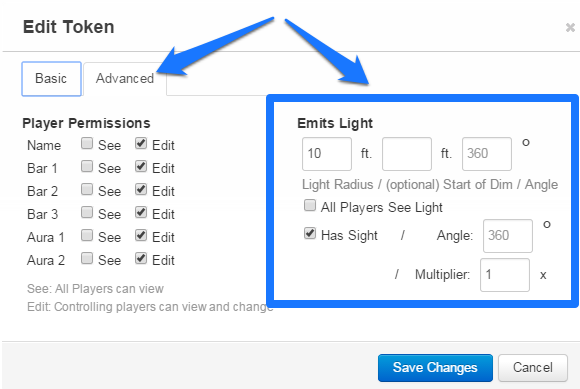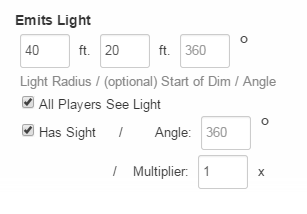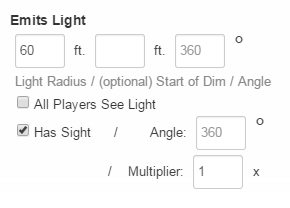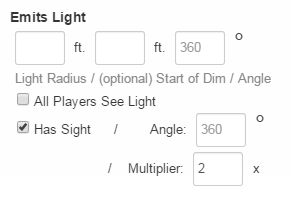Difference between revisions of "Dynamic Lighting Examples"
From Roll20 Wiki
Stephen K. (Talk | contribs) (→Dungeons and Dragons 3rd Edition / Pathfinder) |
Stephen K. (Talk | contribs) |
||
| Line 76: | Line 76: | ||
* [[Dynamic_Lighting#Adding Light|All Players See Light]] = "Checked" | * [[Dynamic_Lighting#Adding Light|All Players See Light]] = "Checked" | ||
| + | [[File:Lighting Example3.PNG|frame|right|Character with darkvision in 4th Edition Dungeons and Dragons.]] | ||
==== Dim Light ==== | ==== Dim Light ==== | ||
Dim light sources are represented much the same as [[#Bright Light|Bright Light]]. There are mechanics in the game that come into play but the only significant difference for how it is used in [[Main_Page|Roll20]] is in the way it's rendered. To show that the light is dim we add a [[Dynamic_Lighting#Adding Light|Start of Dim]] at 0sq. | Dim light sources are represented much the same as [[#Bright Light|Bright Light]]. There are mechanics in the game that come into play but the only significant difference for how it is used in [[Main_Page|Roll20]] is in the way it's rendered. To show that the light is dim we add a [[Dynamic_Lighting#Adding Light|Start of Dim]] at 0sq. | ||
| Line 106: | Line 107: | ||
* [[Dynamic_Lighting#Adding Light|All Players See Light]] = "Checked" | * [[Dynamic_Lighting#Adding Light|All Players See Light]] = "Checked" | ||
| − | |||
==== Low-light Vision ==== | ==== Low-light Vision ==== | ||
Character with low-light vision can see twice as far from light sources. To represent that in [[Main_Page|Roll20]] we set the token's "Multiplier" to "2". This means that a torch normally produces 20ft of bright light and an additional 20ft (out to 40ft) of dim light. To a character with Low-light Vision this same torch would appear to produce 40ft of bright light and and additional 40ft (out to 80ft) of dim light. | Character with low-light vision can see twice as far from light sources. To represent that in [[Main_Page|Roll20]] we set the token's "Multiplier" to "2". This means that a torch normally produces 20ft of bright light and an additional 20ft (out to 40ft) of dim light. To a character with Low-light Vision this same torch would appear to produce 40ft of bright light and and additional 40ft (out to 80ft) of dim light. | ||
Revision as of 04:16, 21 November 2014
Dynamic Lighting is an advanced map lighting tool currently available to Mentor & Subscriber users. It calculates line of sight on the fly as tokens are moved across the tabletop. This sections give general and system specific examples of how to set up lighting and vision.
To turn Dynamic Lighting on you must enable it from the Page Settings for each scene you wish to include lighting elements. Remember that a user will only see light sources if they have control over a token that Has Sight enabled. You can activate this setting from the Advanced tab in the Edit Token pane while in the GM view. If the Enforce Line of Sight option is selected in the Page Settings the user will only be able to see light sources that their token is able to see.
The measurements for light distance and vision are calculated using the Page Settings for each individual scene. Whatever the Scale unit measurement is set to (feet, squares, inches, kilometers) is what the units of light range will be calculated in. These examples assume that you are using the default measurements of 5 Feet for each 1 unit but can be converted to any measurement.
Contents |
System Agnostic Lighting
These are general lighting examples that will work in any system without specific vision rules. They can been tweaked until the best fit the themes and mood of your game.
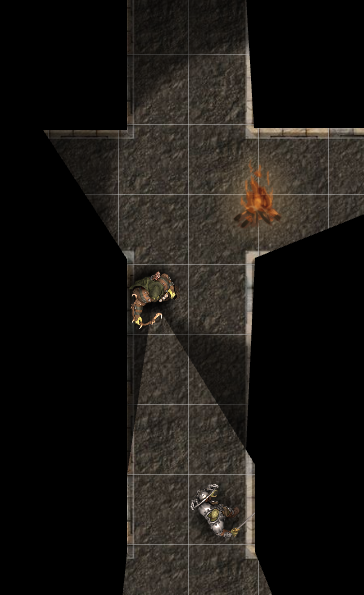
Lantern
The lantern is a mobile 360 degree light source that can represent anything from a torch to an electric lamp. Since the light source is mobile and being carried by a character, then it's best to give the player's token a Light Radius under the Emits Light section. The All Players See Light options should be checked. Based on the themes of your game your may wish to have the light "fall off" by getting dimmer the further it travels from it's source. You can do this by putting in the (optional) Start of Dim amount. A good default for this is half the value of the Light Radius. For example, if the lantern's Light Radius is 30 feet, you would set the Start of Dim to 15 feet.
Campfire
The campfire represents static sources of light, from wall sconces to street lights. Since they won't be moving, campfires are best represented as new tokens. The campfire should receive a Light Radius and have All Players See Light just like the Lantern. However, since it isn't attached to a player, it should not have Has Sight enabled. It's a safe idea to move these static sources of light to the Map Layer so that they don't accidentally get moved.
Glow Stick
Use a glow stick for very dim light sources, such as a patch of incandescent mushrooms, glowing coals, or a luminescent barrel of radioactive waste. The glow stick is prepared based on it's mobility like either a Lantern or a Campfire light source. The difference is that the option Start of Dim setting is set very low or even zero. An example might be a lit match, prepared like a Lantern but set with a Light Radius of only 5 feet and a Start of Dim of just 1 foot. This is an excellent way to reduce visibility and increase dramatic tension.
Flashlight
If you want to restrict the angle of a light source use the flashlight. It's prepared mobile or static like a "hooded" Lantern or static like a spotlight. The difference is that the Angle attribute is set in the Emit's Light section of the Advanced tab of the Edit Token menu. Typically a flashlight will have between a 20 and 60 degree angle of vision. For example, a hooded lantern might have a 60ft Light Radius, a 30ft Start of Dim, and a 40 degree angle.
Super Senses
Night vision, cat eyes, or low light vision are all ideas of being able to see more clearly in low light environments. To simulate this we use the light Multiplier feature under the Has Sight options. To make use of the Multiplier the token must have Has Sight checked. The multiplier amplifies the Light Radius of all light sources the token is able to see. To a token that has a Multiplier of 2, twice as good as normal vision, a Campfire that normally gives off 30ft of illumination and 15ft of dim light would appear to give off 60ft and 30ft.
Alternate Senses
Alternate Senses represents the idea of having "sight" that don't have anything to do with normal light. They work in complete darkness, such as thermal vision, echo location, or mystical perfect awareness. To simulate this we set up a light source similar to a Lantern on our token but do not include All Players See Light option. This allows this token alone to "see" while not actually producing light or giving any other tokens sight. An example of Infrared Vision might look like a Light Radius of 60ft, All Players See Light is disabled, but Has Sight is enabled.
Daylight
Daylight or other forms of perfect illumination such as a well lit building can be set from the Page Settings menu for the scene you're trying to make day lit. By toggling the Global Illumination option you add a light source that illuminates the entire map. This is useful in creating situations where vision isn't restricted due to lack of light but only by Light Obstructions, such as walls, trees, or boulders. These Obstructions can be added from the Dynamic Lighting Layer.
Realistic Vision
A good way to simulate "realistic" field of visions, meaning that a token cannot see in 360 degrees, is to set the Angle next to Has Sight to 120 degrees. This works similarly to a Flashlight but only affects the light a token is able to see, rather than producing light everyone can see. Another option might be to extend Angle to 240 degrees to represent someone who is alert and aware of their surroundings, regularly checking their periphery vision, but still not able to see directly behind them.
System Specific Lighting
This section will give you exact Dynamic Lighting set ups for some of your favorite systems.
Dungeons and Dragons 5th Edition
Fifth edition Dungeons and Dragons has more in common with 3.5/Pathfinder than differences. Below you'll find specific examples of how to set up lighting and vision in Roll20 for D&D5e. To best represent Dynamic Lighting in 5e you'll need to enable Dynamic Lighting on the Page Settings. You'll want to Enforce Line of Sight as well. Each character token will need Has Sight checked on the token's Advanced tab of the Edit Token menu.
Light Sources
Whether they're mobile or static, light sources in 5e follow the tradition of producing bright light out to a radius of feet, followed by an equal radius of dim light. The radius is specified in the description of the light source. To represent this in Roll20 you'll set the token's Light Radius to the total range of the light (that's the bright light and dim Light Radius added together) and the Start of Dim setting is the dim Light Radius. Additionally the All Players See Light option should be checked, since the object is producing visible light.
For example, a torch illuminates 20ft of bright light and another 20ft of dim light. To set that up in Roll20 it would look like:
- Light Radius = "40"
- Start of Dim = "20"
- All Players See Light = "Checked"
Blindsight
Characters with blindsight are able to see in ways that don't actually involve normal light. This means that out to a certain radius, usually 60ft, they "see" without light. To represent this we'll create a "light source" for that token, that only that token can see. What separates it from acting like a Lantern is that the All Players See Light box is not checked.
For example, tremorsense of 60ft would look like:
- Light Radius = "60"
- All Players See Light = "Unchecked"
Darkvision
Characters with darkvision are able to see in no light as if it were dim light, and dim light as if it were bright light, usually out to a radius of 60ft. To represent this we'll create a "light source" for that token, that only that token can see. What separates it from acting like a Lantern is that the All Players See Light box is not checked. Furthermore, to check in situations where it might not be obvious where darkvision and sources of natural light are overlapping, it can be helpful to set an aura of 60ft, from the Basic tab of the Edit Token menu, to measure overlap.
For example, darkvision of 60ft would look like:
- Light Radius = "60"
- All Players See Light = "Unchecked"
- Aura 1 = "60"
Dungeons and Dragons 4th Edition
Below you'll find specific examples of how to set up lighting and vision in Roll20 for D&D4e. To best represent Dynamic Lighting in 4e you'll need to enable Dynamic Lighting on the Page Settings page. You'll want to Enforce Line of Sight as well. Each character token will need Has Sight checked on the token's Advanced tab of the Edit Token menu. In addition 4e uses squares as it's unit of measurement. This should be changed on the Page Settings menu so the "Scale" is equal to "1 unit = 1 sq".
Bright Light
Whether they're mobile or static, light sources in 4e follow the tradition of producing bright light out to a radius of squares. Unlike other editions of D&D they do not produce an additional radius of dim light. The radius is specified in the description of the light source. To represent this in Roll20 you'll set the token's Light Radius to the range listed in the handbook. Additionally the All Players See Light option should be checked, since the object is producing visible light.
For example, a torch illuminates 5sq of bright light. To set that up in Roll20 it would look like:
- Light Radius = "5"
- All Players See Light = "Checked"
Dim Light
Dim light sources are represented much the same as Bright Light. There are mechanics in the game that come into play but the only significant difference for how it is used in Roll20 is in the way it's rendered. To show that the light is dim we add a Start of Dim at 0sq.
For example, a candle emits 2sq of dim light. To set that up in Roll20 it would look like:
- Light Radius = "2"
- Start of Dim = "0"
- All Players See Light = "Checked"
Low-light Vision
While Low-light Vision has mechanical benefits in D&D4e, there is no difference in how Low-light Vision is represented in play in a Roll20 scene.
Darkvision
Characters with Darkvision can see effectively in no light. There is no effective range to this vision making is so the character can see perfectly regardless of the lighting situation. To represent this we'll create a "light source" for that token with an effectively unlimited range, that only that token can see. What separates it from acting like a very powerful Lantern is that the All Players See Light box is not checked. What this means is that unless an Obstruction blocks the characters line of sight, they can see everything.
For example, darkvision would look like:
- Light Radius = "1000"
- All Players See Light = "Unchecked"
Dungeons and Dragons 3rd Edition / Pathfinder
Third edition Dungeons and Dragons, 3.5, and Pathfinder all use nearly identical lighting and vision systems. Below you'll find specific examples of how to set up lighting and vision in Roll20 for the above. To best represent vision and lighting you'll need to enable Dynamic Lighting on the Page Settings page. You'll want to Enforce Line of Sight as well. Each character token will need Has Sight checked on the token's Advanced tab of the Edit Token menu.
Light Sources
Whether they're mobile or static, light sources in third edition follow the tradition of producing bright light out to a radius of feet, followed by an equal radius of dim light. The radius is specified in the description of the light source. To represent this in Roll20 you'll set the token's Light Radius to the total range of the light (that's the bright light and dim Light Radius added together) and the Start of Dim setting is the dim Light Radius. Additionally the All Players See Light option should be checked, since the object is producing visible light.
For example, a torch illuminates 20ft of bright light and another 20ft of dim light. To set that up in Roll20 it would look like:
- Light Radius = "40"
- Start of Dim = "20"
- All Players See Light = "Checked"
Low-light Vision
Character with low-light vision can see twice as far from light sources. To represent that in Roll20 we set the token's "Multiplier" to "2". This means that a torch normally produces 20ft of bright light and an additional 20ft (out to 40ft) of dim light. To a character with Low-light Vision this same torch would appear to produce 40ft of bright light and and additional 40ft (out to 80ft) of dim light.
An example of low-light vision would look like:
- Multiplier = "2"
Darkvision
Characters with darkvision are able to see in ways that don't actually involve normal light. This means that out to a certain radius, usually 60ft, they "see" without light. To represent this we'll create a "light source" for that token, that only that token can see. What separates it from acting like a Lantern is that the All Players See Light box is not checked.
For example, darkvision of 60ft would look like:
- Light Radius = "60"
- All Players See Light = "Unchecked"
Advanced Dungeons and Dragons 2nd Edition
Below you'll find specific examples of how to set up lighting and vision for Advanced Dungeons and Dragons in a Roll20 campaign. To best represent lighting and vision in AD&D you'll need to enable Dynamic Lighting on the Page Settings page. You'll want to Enforce Line of Sight as well. Each character token will need Has Sight checked on the token's Advanced tab of the Edit Token menu.
Light Sources
Whether they're mobile or static, light sources in AD&D follow the tradition of producing bright light out to a radius in feet. Unlike other editions of D&D they do not produce an additional radius of dim light. The radius is specified in the description of the light source. To represent this in Roll20 you'll set the token's Light Radius to the range listed in the handbook. Additionally the "All Players See Light" option should be checked, since the object is producing visible light.
For example, a torch illuminates 40 feet of light. To set that up in Roll20 it would look like:
- Light Radius = "40"
- All Players See Light = "Checked"
Infravision
Characters with infrakvision are able to see in ways that don't actually involve normal light. This means that out to a certain radius, usually 60ft, they "see" without light. To represent this we'll create a "light source" for that token, that only that token can see. What separates it from acting like a Lantern is that the "All Players See Light" box is not checked.
For example, infrakvision of 60ft would look like:
- Light Radius = "60"
- All Players See Light = "Unchecked"
Ultravision
Characters with Ultravision can see effectively in no light. There is no effective range to this vision making is so the character can see perfectly regardless of the lighting situation. To represent this we'll create a "light source" for that token with an effectively unlimited range, that only that token can see. What separates it from acting like a very powerful Lantern is that the "All Players See Light" box is not checked. What this means is that unless an Obstruction blocks the characters line of sight, they can see everything.
For example, ultravision would look like:
- Light Radius = "1000"
- All Players See Light = "Unchecked"





